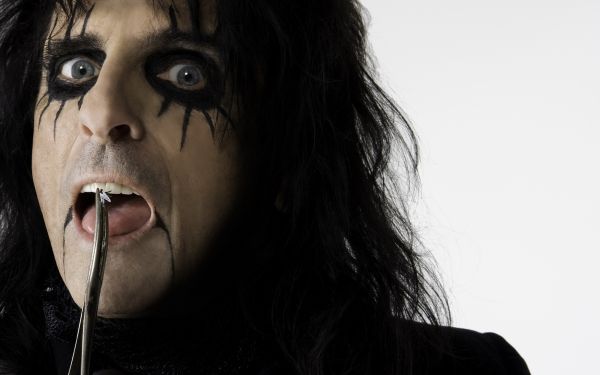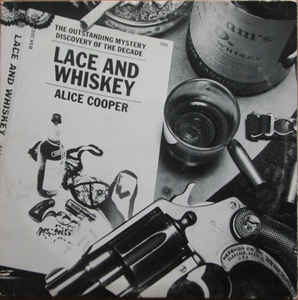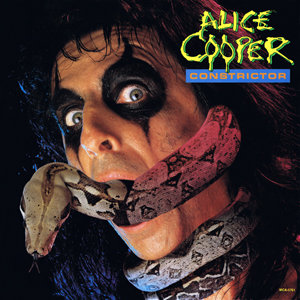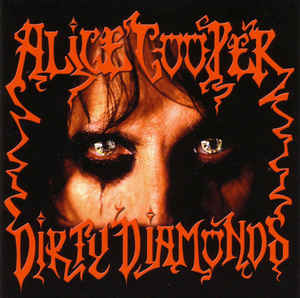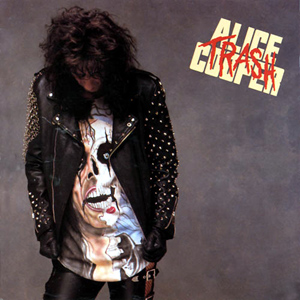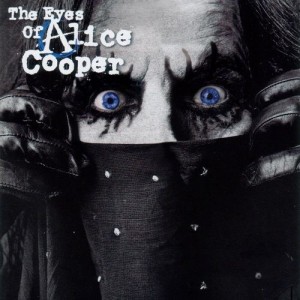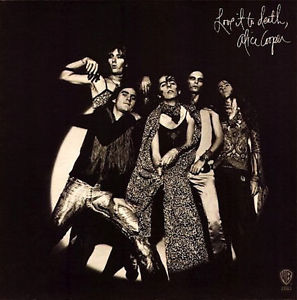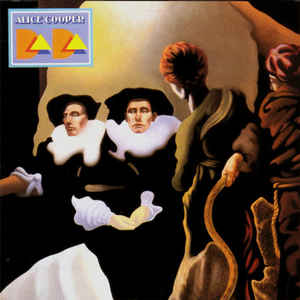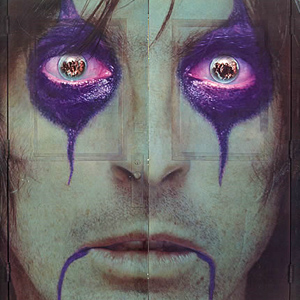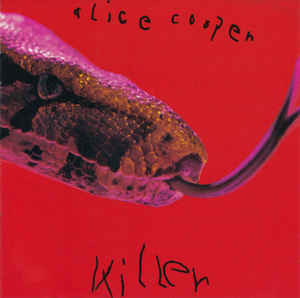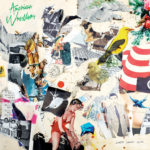I always start thinking of Alice Cooper around this time of year. He’s the ultimate Halloween artist, isn’t he? He knows a lot of what he does has kitsch value and these days he plays that card pretty heavy (probably the best way for him to survive in the modern day). But I think that underplays his contributions. Before Alice Cooper, there was no goth, there was no punk, there was no glam, there was no metal, there was no spectacle in rock & roll. He either invented, or took to a new level, things that today we take for granted.
If you want a handful of disparate examples of people who wouldn’t exist without Alice Cooper’s influence, the list is pretty staggering. David Bowie didn’t create Ziggy Stardust until he saw Alice Cooper play at Wembley Arena, Madonna’s conceptual live shows are right out of the Alice handbook, Johnny Rotten got the Sex Pistols gig by lip synching to I’m Eighteen on a jukebox, Michael Jackson borrowed heavily from Alice for Thriller, Talking Heads were inspired by Alice to write Psycho Killer.
Boy George, The Flaming Lips, Lady GaGa, The Cure, Adam Ant, KISS, Motley Crue, Kurt Cobain, Megadeth, Ke$ha. It is a bizarre mix of people who don’t necessarily fit together. Even Bob Dylan is a fan of The Coop, famously telling Rolling Stone what “an overlooked songwriter” he believes him to be in 1978. It is also worth noting that some bizarre famous fans who went on record as such included ye olde time showbiz legends such as Groucho Marx and Mae West.
But…he is far too often lumped into the glam metal clique (thank you very much, the 80s). His catalogue is far deeper and more eclectic than anyone coming in from the outside would expect. But then, look at who he declares his influences. Yes, The Beatles. Yes, The Stones. Yes, The Yardbirds. But also Salvador Dali, Bela Lugosi, Vincent Price, René Magritte, West Side Story, and Liza Minelli once told the story that Cooper informed her that most of his career was “based on Cabaret”. These aren’t your regular rock star influences. So, yeah, he’s going to want to experiment a little bit.
Before 1975, Alice Cooper was a band as well as their singer. It is extremely easy to forget how shocking they were. Half of what was claimed never really happened, and he would say later that all he did was present the audience with a series of images and it was the in the audiences own mind where the real sick stuff happened. No two reviews of the same show seemed to be the same. There had been nothing like it before in rock & roll, and he was smart enough to know that couldn’t last forever.
Since the original Alice Cooper band split and he went solo in the mid-70s he has occasionally showed up as more of a pop culture icon. When responding to why he did shows like Hollywood Squares, he responded that he felt it was something of a “pop art statement”. The woman who won the car and took away the top prize wouldn’t allow her kids to go to his shows. Isn’t that kinda funny? I think it is. Unlike his disobedient children, like Marilyn Manson or Slipknot or even David Bowie, it seems that Alice always wanted to do things with an element of humour or irony. Maybe that, along with the total, career-long dismay of all the boring, serious rock press, is why he ended up being more popular in the UK.
The original band’s material is usually considered superior, but I’ve never quite bought that. There is a section of the audience who will only accept Alice when he RAWKS. As much as I love those albums, I am often much more interested in what Alice is doing when he tries on something else, so some of the more experimental albums are rated higher than some of those considered “classics”. I also haven’t included the album from the Alice/Joe Perry/Johnny Depp supergroup Hollywood Vampires, cos they’re mainly just doing covers, which I’m sure is fun for them but not really anything worth getting excited about. In fact the album would definitely be dead bottom of this list anyway.
So, yeah – here we go…rating every single Alice Cooper album. Original Alice Cooper band albums are denoted with an asterisk to differentiate.
It’s frustrating that this album is so poor, because I actually really like the concept. Deciding to leave the horror imagery that he had been building over the previous decade to one side, he took on the persona of a heavy drinking private investigator, inspired by film noirs of the 40s and 50s. Part of me believes that the reason this comes up so short is down to the real life heavy drinking that Alice was doing at the time. This led to his stay in a mental institution shortly after the album’s tour, which was plagued by poor performances, despite the pretty cool concept. It’s Hot Tonight has a mega riff though.
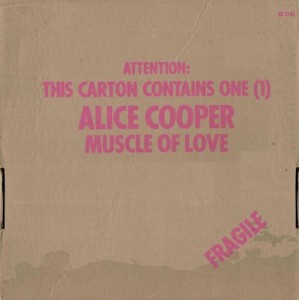
25. Muscle of Love [1973]*
The original Alice Cooper band were so huge in 1973 that they figured they could release any old shit and it would sell, and that’s exactly what happened. Made without Bob Ezrin (it shows), the band sound tired and in much need of a break. Still, Teenage Lament ’74 is an oft overlooked classic and the title track works a treat. The Man With The Golden Gun was written for the Bond film of the same name but was never used, but interestingly features gay icons such as Ronnie Spector, Liza Minelli and The Pointer Sisters on background vocals. Lulu ended up singing the official theme. More fool them. Unfortunately, this was the original band’s final album (although they did briefly reunite without Alice as Billion Dollar Babies a few years later).
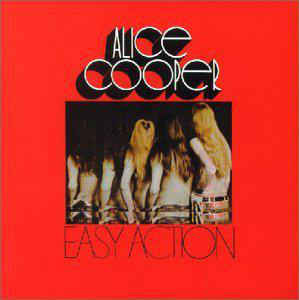
24. Easy Action [1970]*
The second and final album that the band released on Frank Zappa’s Straight label. There are some good moments, the seven-minute trip Lay Down and Die, Goodbye, opener Mr and Misdemeanor, and notably Refrigerator Heaven would be referenced on the later Cold Ethyl. But ultimately it doesn’t feel quite so present as the debut, even if it does capture the sound of the band evolving.
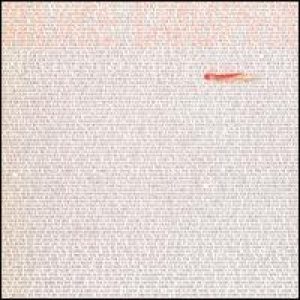
23. Zipper Catches Skin [1982]
There is a run of four Alice Cooper albums between 1980 and 1983 that are known as the “blackout” albums, meaning Alice has no recollection of writing, recording or promoting them. Not long after his stay in a mental institution for alcoholism, he apparently decided that if he couldn’t drink, he would just freebase cocaine instead, and sank so deeply into this new addiction that he has one massive “scene missing” title card in his mind for most of this period. This is mainly a forgettable effort, despite lead single I Am The Future being pretty cool (if a little on the nose).
It made sense that Alice would make his comeback around this time. Some stars were definitely aligning for him. Firstly, this was during the heyday of hair metal. In many ways, Alice did pave the way for these bands (though none of them had any of the witty satire that Alice’s work is peppered with), and they all openly acknowledged their debt to him. Secondly, MTV was in full force, and Alice’s strong visuals were perfect for the video age. In fact, his comeback concert was broadcast live on MTV on Halloween 1986, and is one of the ultimate Alice Cooper live shows. Lastly, this was also the apex of the slasher flick, meaning that there was also an audience hungry for grotesque violence and gore, so it is no surprise that Constrictor’s lead single was He’s Back (The Man Behind The Mask), which also featured in Friday The 13th Part VI: Jason Lives. It’s what a lot of people expect from Alice Cooper, but it’s far from his most interesting work. Fun though.
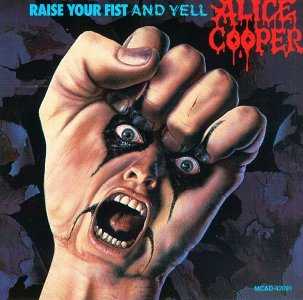
21. Raise Your Fist and Yell [1987]
This only slightly pips Constrictor due to its last couple of tracks, which almost recall Welcome To My Nightmare for the 80s hair metal years. The trilogy of songs that end the record – Chop Chop Chop, Gail and Roses on White Lace – are as terrifying as anything The Coop had put out in the past. It is a pity that the unashamedly 80s sound has aged so badly, because the songs and concept has the potential to be much more revered. It is patchy though, with the first half of the album seeming to take issue with Tipper Gore’s Parents Music Resource Centre and their call for censorship, which sadly Alice vocalises with lines like “Freedom to rock”, which just sounds horribly clichéd. Awful cover too.
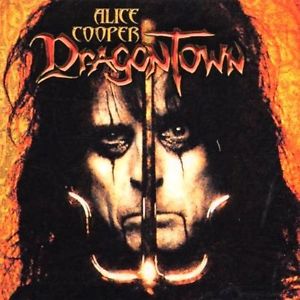
20. Dragontown [2001]
As much as it made sense for Alice to engage with hair metal, it was a given that he would take on the industrial metal of Nine Inch Nails and, most obviously, his bastard child Marilyn Manson. He made two albums of this ilk; 2000’s Brutal Planet and Dragontown the following year. Described by Alice as “The worst place on Brutal Planet”, it is hard to know if this is a genuinely crafted sequel or an album of leftovers. Personally, I have much more fondness for Brutal Planet, so I tend to be in the latter camp and kind of feel like he is doing something he had just done pretty much as well as he could. But there are plenty of people who believe this is the superior album.
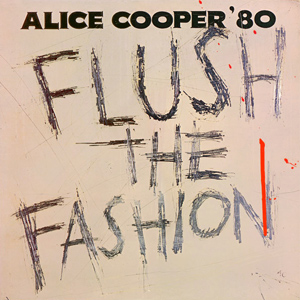
19. Flush The Fashion [1980]
This is a real oddity in Alice’s back catalogue. Here we find our anti-hero produced by Roy Thomas Baker, who is most famous for his work with Queen and The Cars. Stylistically, it sounds a little like the latter, which suffice to say is not what people expected from Alice Cooper at the time. But then, there was a time when nobody expected Only Women Bleed from Alice Cooper either. It is Alice’s shortest album, and often gets unfairly slated. The minor hit Clones (We’re All) still occasionally gets a live airing in a more metallic form, and Pain is something of a lost classic, with lyrics from the point of view of the living embodiment of the pain you have inside you.
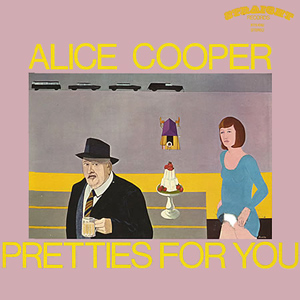
18. Pretties For You [1969]*
The original band’s debut was on Frank Zappa’s Straight label and produced by Zappa himself. Even for Zappa’s audience this was too out there at the time, and it tanked considerably. This is more of a psych album than the kind of hard rock album that the band would later make, and none of the songs have been played since the release of Love It To Death two years later. Which is a shame, because it would be cool to see Alice resurrect something like the spaced out Levity Ball now. Lead single Reflected was later remade into the superior political satire Elected. It is worth checking out, especially if you’re a psych fan, but it loses a few points because it doesn’t really feel like a Alice Cooper album.
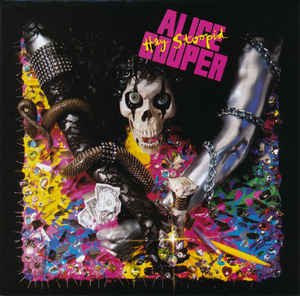
17. Hey Stoopid [1991]
There aren’t many great moments on this one, but it works on the whole. It is almost a spiritual sequel to Trash, except where on that album it felt more like Desmond Child was in charge, here Alice is very much front and centre. There are more collaborations here though, which does distract slightly. Due to its appearance in Wayne’s World, Feed My Frankenstein is probably the album’s best known song, and aside from the co-write with Zodiac Mindwarp, it also features Joe Satriani, Steve Vai, Nikki Sixx from Motley Crue and Elvira. Slash and Ozzy Osbourne show up on the title track, and there’s more from Motley Crue with Mick Mars. Ergo, it often feels very much of its time, but there are a few moments were everything clicks, not least on the epic Might As Well Be On Mars, which reunites Alice with Nightmare-era guitarist Dick Wagner.
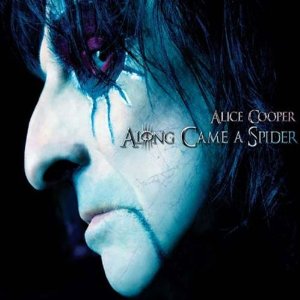
16. Along Came a Spider [2008]
This is a bit of an odd one. It’s his first true concept album since 1994’s The Last Temptation, and probably his most ambitious since From The Inside, but I feel like there is a much better album in there somewhere, but there is something that doesn’t gel quite as well as one would hope. The album’s actual story is full-on Alice; a serial killer named Spider cocoons his victims in a silk web, and are each missing a leg. Spider’s task is to collect eight legs in order to complete the construction of his own spider. However, he falls in love with his eighth victim. I would have liked to have seen a full theatrical tour for this album to bring the story to life, which was promised but never materialised. Instead, he embarked on the Theatre of Death tour, featuring just Vengeance Is Mine from Along Came A Spider…which I’m not complaining about as it was probably my favourite of all the Alice Cooper shows I have seen. Musically, it seems to be placed somewhere between the industrial metal of Brutal Planet and Dragontown, and the garage rock of his previous two releases. Like Lace and Whiskey, a real wasted opportunity, but a much more satisfying one.
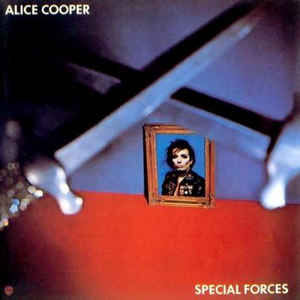
15. Special Forces [1981]
This one picks up where Flush The Fashion left off, but there is something a little more defined about it. Alice takes a military feel to both the music and the imagery of the album. Another one that I personally think gets unfairly trashed by Cooper’s fan base, although there is a feeling that it could have been better. This is one of the “blackout” albums, that Alice has little to know memory of recording due to his freebasing habit. Take a look at the Alice in Paris TV special from this period and you can see exactly how bad it was. On the one hand, Alice looks terrifying, which is cool until you realise he doesn’t look terrifying because of the make-up, but because he looks like he’s about to die. Highlights here include The Prettiest Cop on the Block, Who Do You Think We Are? and You Look Good In Rags, which is a little reminiscent of Blondie’s Atomic. Low points include a pointless version of Love’s Seven and Seven Is and an even more pointless remake of the earlier Generation Landslide. There is an outtake from the album that was released in 1999’s The Life and Crimes of Alice Cooper box set called Look At You Over There, Ripping The Sawdust From My Teddy Bear that is better than anything released on the album.
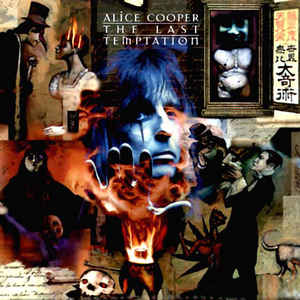
14. The Last Temptation [1994]
The Last Temptation was made at an interesting time for Alice. It was his first post-grunge album, and unlike the other bands engaging with hair metal, he fit in with the grunge kids too because, hey, was he not as much a hero to Kurt Cobain as he was to Motley Crue? Yeah, of course he was. He didn’t go full-on grunge, I’m not sure anyone would have believed that. But the excesses of his previous stretch of albums were toned down, and there is a return to the more conceptual work that he thrives in. I want to like this album more than I actually do, and I’ve never been able to put my finger on why I’m not a massive fan of it, because objectively there is a case for some of this being amongst his best work. Still adore opener Sideshow though.
Alice seemed to just want to have some fun after the darkness of his industrial period. It was just as the likes of The White Stripes were coming forward with a new form of garage rock. Presumably The Coop decided to show them who is boss and made a couple of balls to the wall albums with his current band. Both of them are hugely enjoyable listens, but probably aren’t ones I would recommend people who know nothing about Cooper go listen to. This was the second of those albums, and like Dragontown, I feel like it’s a slightly lesser version of the album before it. That’s not to say it’s much less worthy. Despite a false start with the eye-rollingly-titled Woman of Mass Distraction there are a lot of major highlights peppered throughout, not least the title track which has been a mainstay of the setlist ever since and packs a much heavier punch on stage.
The one with Poison on it. This really put Alice back on the map in a big way, especially in Europe. There isn’t as much classic Coop snarl on this one, and it has way more sheen than most Alice albums, but it is one of his most enjoyable for his total embrace of the cheesier side of his persona. Desmond Child does the honours in the production seat, and it maybe sounds more like a late-80s Desmond Child album as it does an Alice Cooper album, but the hooks are infectious, not just on Poison, but on House of Fire, This Maniac’s In Love With You, Spark In The Dark and the power ballad Only My Heart Talkin’ (featuring Steven Tyler). I guess it is like KFC. I know it’s crap, no good for me and isn’t even made with real chicken, but it feels too good to indulge in it occasionally. If I wished I liked The Last Temptation more, I wish I liked Trash less.
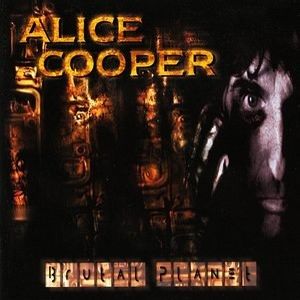
11. Brutal Planet [2000]
The first of Cooper’s industrial albums is also one of the few times you’ll see an outwardly political (with a small “P”) Alice as he tackles subjects from prejudice (Blow Me a Kiss), school shootings (Wicked Young Man), war (Pick Up The Bones) and he returns to the subject of domestic violence (Take It Like a Woman). Though not a commercial success, it is a major favourite amongst fans and, along with Dragontown, by far the heaviest albums of his career – both musically and in subject matter. In a way, Alice’s act has always been a bit of a morality play. He is always punished for his sins on stage, and Brutal Planet is probably one of the most obvious examples of this morality play on record. I also have fondness for the outtake Can’t Sleep, Clowns Will Eat Me because I’m a massive Simpsons fan.
10. The Eyes of Alice Cooper [2003]
The first of the garage rock couplet is slightly more solid for me. It is easily accessible and is full of great hooks that could easily have fitted on the radio amongst the likes of Fountains of Wayne, Good Charlotte and Wheetus at the time, but with more grit (see: Novocaine, Between High School and Old School) and lyrics that border on the hilarious (The Song That Didn’t Rhyme berates the listener that they have given him $12.99 for the lousy song they are currently listening to), whilst Detroit City pays tribute to the musical heroes from Alice’s hometown and a horn section helps pack a punch to Bye Bye Baby.
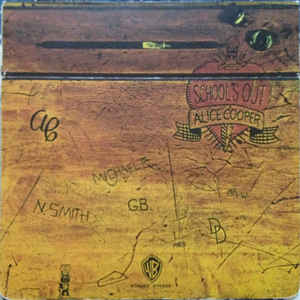
9. School’s Out [1972]*
Despite the iconic title track, I’ve always felt like the album on the whole didn’t quite match up. It’s hard to follow up an anthem that everybody knows and loves, but they have a good go of it. Grand Finale ends the album and despite the fun influence of movie scores, it does feel more like filler. Gutter Cat Vs The Jets is an obvious homage to West Side Story (which, I swear, you would not have found any other major rock band paying tribute to in 1972), and Public Enemy #9 has just been resurrected in Cooper’s most recent live shows. The other real highlights on this album for me are the strange jazz of Blue Turk and the bizarre My Stars.
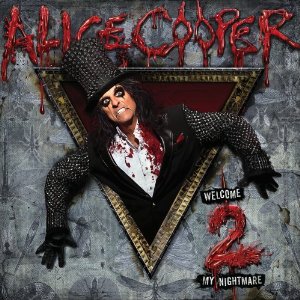
8. Welcome 2 My Nightmare [2011]
The fact that Alice’s most recent album can be in the Top 10 shows just how overlooked some of his more recent records have been. This is a sequel to his solo debut, 1975’s Welcome To My Nightmare (notice the numerical “2” in the title of this one), and features mini-reunions with several key players from his past, such as producer Bob Ezrin and, most notably, the original band on three of the album’s strongest tracks; A Runaway Train, When Hell Comes Home and lead single (and a song I defy you not to be singing along to by the second chorus) I’ll Bite Your Face Off. There is also former guitarists Dick Wagner and Steve Hunter, and former bassist Kip Winger showing up here and there are cameos from Rob Zombie and John 5. The real shocker – and I wouldn’t be surprised if he did it just to piss off his own audience – was Ke$ha playing the part of the devil on What Baby Wants. What is most striking is that the album mainly sounds thoroughly contemporary despite the nods to the past. Shout-out to the Tom Waits-ish Last Man On Earth too. If he never makes another album, this is a good one to go out on. “What part of dead don’t you get?”
Love It To Death marked a massive change from the Zappa-era albums. After being chased out of LA (seriously – nobody wanted anything to do with them whilst Jackson Browne and David Crosby ruled the town), the band landed in Detroit and found they were right at home with The Stooges, the MC5 and Funkadelic. This is also the first album they made with Bob Ezrin in the producer’s chair, who managed to bring the band’s strengths out of them. A 10 minute song they used to warm up that Ezrin thought was called I’m Edgy was re-crafted with his help. When the resulting I’m Eighteen came out it finally put Alice Cooper on the map. This is probably the most gothic album they made, especially with the likes of Black JuJu, and the epic Ballad of Dwight Fry.
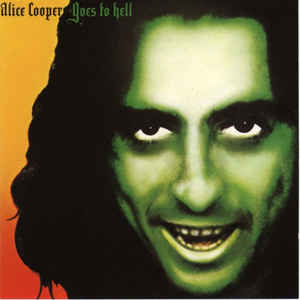
6. Alice Cooper Goes To Hell [1976]
If Alice’s Broadway influence is ramped up on Welcome To My Nightmare, on the follow-up we get a bit more vaudeville. Not only in the likes of the tongue-in-cheek Give The Kid a Break, but he even covers the old vaudeville standard I’m Always Chasing Rainbows towards the end of the record. Like …Nightmare it is a very eclectic album, with the blandest disco being depicted as hell, rockers like Guilty and the tender ballad I Never Cry. Personally speaking, this has always been my favourite of Coop’s ballads, and it is – for that time at least – surprisingly personal. It deals with his alcoholism in stark frankness; “Sometimes I drink more than I need, until the TV’s dead and gone/I may be lonely, but I’m never alone/And the night may pass me by, but I never cry”. The opening title track is probably the last song until Poison to remain in his sets throughout his career.
Even for Alice Cooper, this album is dark. And weird. Very, very weird. This is by far the best of the “blackout” albums, and it gives a fairly decent snapshot of Cooper’s mental state at the time. I have no idea what is going on with the opening, mainly instrumental title track, but I’m pretty sure it is fucked up. I Love America is the kind of satire that you would really expect from someone a little more lucid, and there is a glorious pun that forms the nucleus of Dyslexia. By the time you get to the chilling closer Pass The Gun Around, you’re not quite sure what has happened, but you are intrigued and want to take it back to the beginning and try to figure the record out. Like the previous album, Alice didn’t tour in support of DaDa, so none of the songs were ever performed live. When Alice returned it was in the much more conventional hair metal phase. I would really like him to revisit some of this stuff in some form.
4. From The Inside [1978]
This is another one of Alice’s grossly underappreciated records, and a collaboration with Bernie Taupin (of all people). Having being thrown into a sanatorium to cure his alcoholism, he made this album which was about the characters he came across during his stay. There aren’t really (m)any stone cold Cooper classics on this one, aside from the ballad How You Gonna See Me Now? – supposedly based on a letter he wrote to his wife during his stay, as he battled with the fact that she had never seen him sober – which ended up being his last Top 20 hit in the US until Poison over a decade later. The rest of the album is much less sappy, with the pervert priest lusting after Nurse Rozetta, the character in the song The Quiet Room being thrown into solitary confinement to stop him committing suicide, the murdering lovers in Millie and Billie and the rich LA scene-ster who lost her mind in Cartier in Wish I Were Born In Beverly Hills (which he randomly resurrected on the 2005 Dirty Diamonds tour, complete with Paris Hilton being mauled by her Chihuahua). Probably the classiest sounding album of his career.
One of the absolute essential Alice records. You could probably go as far as to say that if you want to know what the original Alice Cooper band was about, this is the one to check out. Under My Wheels is garage rock 101 and is still often used a set closer, and Be My Lover picks up where that leaves us. Then things start getting weird with the 8-minute Halo of Flies, which is one of the most complex pieces the band ever played. Desperado was a tribute to Jim Morrison (and you could actually imagine Morrison singing it without it ever sounding like The Doors). The final two tracks on the album formed the basis of the Alice Cooper Show for the ages; Dead Babies and Killer. Although arguably written with the stage show in mind, the theatricality definitely comes across on record. On stage, Alice would chop up dolls of babies, which he was using as a commentary on child abuse, the point of which being lost on casual listeners (let’s call them Joanne and Cleetus), who caused uproar. But if that caused uproar, imagine what happened when Alice was hung for doing so on stage during Killer.
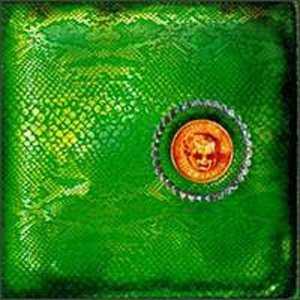
2. Billion Dollar Babies [1973]*
With this album, Alice Cooper became one of the biggest bands in the world, and rightly so. By now everything was honed to its grimey perfection, from the material to the image and the stage show. Opener Hello Hooray has the most Broadway that the original band had displayed on record, Elected is a brilliant political satire that John Lennon claimed as one of his favourite songs, No More Mr Nice Guy echoes 60s invasion bands with a Cooper twist (the lyric was apparently inspired by the reaction Alice’s parents received when their church group found out who their son was), the title track – with its monster drum intro – parodies the band’s own success and features Donovan of all people, Mary Ann seems to taunting Mary Whitehouse and closer I Love The Dead is one of the creepiest songs ever written, though in later years has been underused on stage as the theme for Alice’s execution. This is a genuine classic, not just for Alice Cooper, but in rock & roll. There is not one dud.
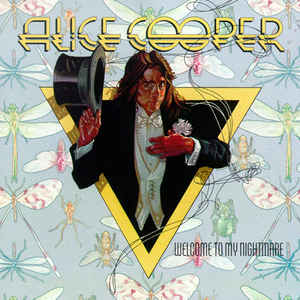
1. Welcome To My Nightmare [1975]
It was a toss-up between this and Billion Dollar Babies for the top spot, and purists would balk at the very idea that this would go over anything the original band did, but I love the sheer theatricality of …Nightmare. Very little of it sounds like it could have been a song by the original band, with the probable exception of the likes of Cold Ethyl, but a song like Only Women Bleed – which has become something of a feminist anthem having been covered by everyone from Tina Turner to Elkie Brooks via Tori Amos and Etta James – is a far cry from anything the original band would have done. Even more of a departure was the jazzy Some Folks and the disco-sounding horns at the end of the title track. Horror icon Vincent Price shows up on Devil’s Food a full seven years before Michael Jackson used him on Thriller, and even starred in an Emmy winning TV special with Alice that basically acts as the first long form music video.
What is interesting is that we discover three quarters of the way through the album that we haven’t been following Alice’s story. Much like the fellow Detroit native Marshall Matthers/Eminem/Slim Shady triangle, here we have Vincent Furnier as Alice Cooper as somebody called Steven.
Who is Steven? That is kind of open to interpretation. In Years Ago, it sounds like Steven is schizophrenic. He sings like a scared little boy, but occasionally his inner voice responds in a deep, mature voice (“I’m a little boy/No, I’m a great big man/No, let’s be a little boy for a little while longer, maybe an hour?”). But, which one is the inner voice?
Fans of the harder edged Coop might want to start elsewhere, but as someone who loves Alice’s experimentation and vaudeville indulgences, this is a masterpiece.

